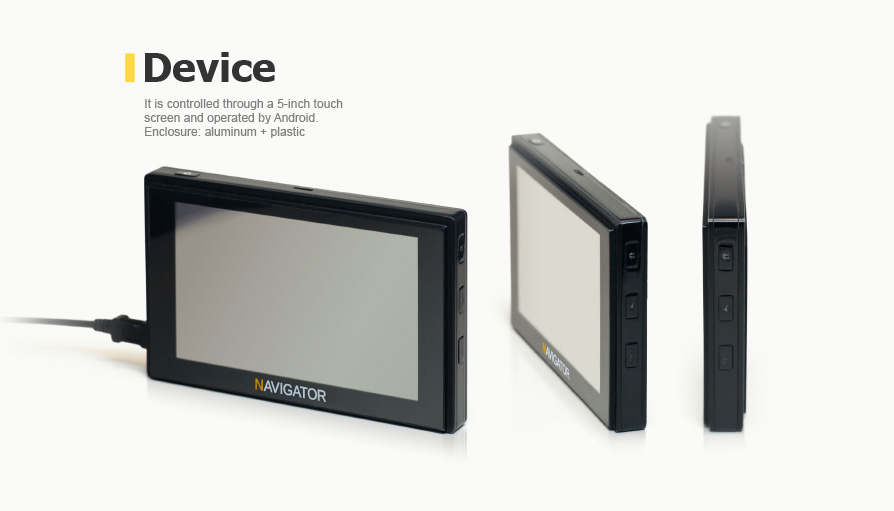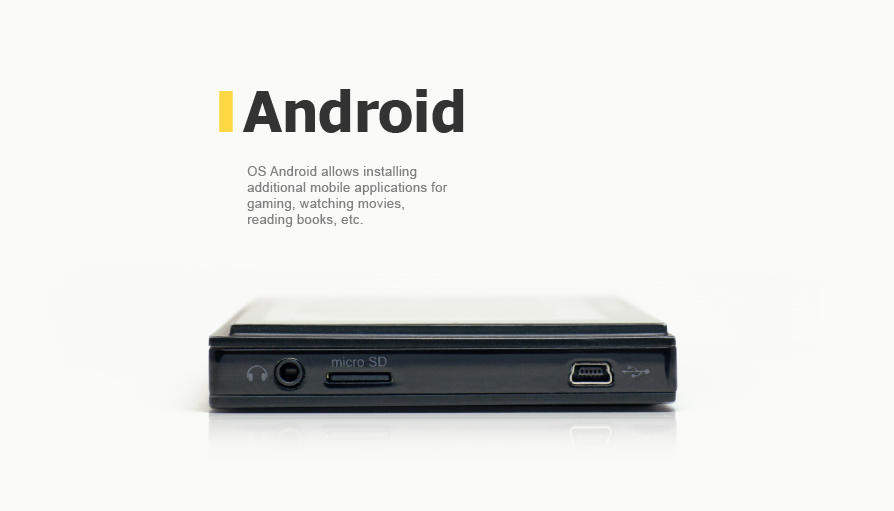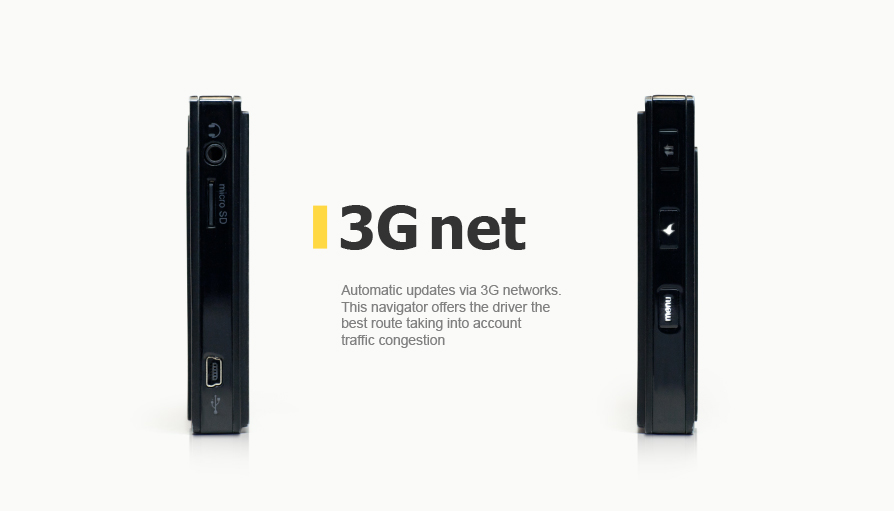Customer
A design bureau (manufacturer of navigation modules).
Objective
The device should be fitted with a large 5-inch touch screen and automatically update traffic information through data transmission in 3G networks to create the best route allowing for traffic congestion.
Solution
Major development tasks include:
- Software development and testing
- Development of a graphic user interface
- Development of software for hardware testing at the place of production
1. Design
At the first stage of development, graphic images of various designs were provided for the customer, some of which are shown below:
After a design focus was selected, the engineers began to work more profoundly on the design of individual parts and implementation options for controls, connectors and materials. Several working drafts produced at this stage are shown below:
The final stage of in-depth design development involved the creation of renderings visually reflecting the product’s appearance after manufacturing. A 3D model of the product was created based on specified materials, colors and textures. Here are some output renderings:
2. Structure
Promwad developers were able to implement the required functionality in a stylish and durable enclosure performed in a small form factor.
The frame structure consists of a durable chassis (middle part) made of an aluminum alloy, plastic top and bottom panels, protective glass and a battery cover.
The aluminum chassis serves as the central load-carrying element, on which the top and bottom plastic panels are mounted with screws and latches. The protective glass is attached to the top panel. The shape of the buttons fitted with spring elements creates a clear tactile effect.
The device can be attached to the windshield of a car with a holder. Product maintainability is provided.
Enclosure prototyping was carried out using FDM modeling to test the assemblability and conjugacy of technological apertures inherent in the design and structure of the device with the required PCB connectors and components.
The final stage of development involved the manufacturing of several enclosure samples by milling, based on the specified materials, colors and surface textures, including the middle metal part of the enclosure.
3. PCB Design
The PCB layout was arranged in compliance with the engineering and design requirements. Cooperation between the design engineer and the PCB designer was set up using a 3D PCB model based on the location and installation of key and large components, such as a navigation module, buttons, connectors, antennas, a GSM/3G modem, and a touch screen. This helped reduce the number of iterations in the design of the enclosure and the device components.
To provide the required wave and differential resistance, as well as ensure the integrity of high-frequency signals, the design team calculated conductor parameters, as well as selected and designed the PCB layout. In addition, the choice of the number of layers (8) was determined by four BGA enclosures, specific EMC requirements and high mounting density. A special development focus was the division of the high-speed digital area and the super-high frequency area of the PCB. To meet the EMC requirements, high-frequency shields were used to eliminate the mutual influence of these functionally different PCB areas.
After the topology design was created, a set of design documents for PCB manufacturing and assembly.
Key parameters of the developed PCB and the topology image are shown below:
| PCB type | digital |
| Number of layers | 8 |
| BGA packages | 4 BGAs |
| Size, mm | 131,6х79,4 |
| Number of bonds | 1694 |
| Number of components | 437 |
4. Hardware Platform
The navigation device is based on the AM3517 processor by Texas Instruments. This processor is built on the ARM Cortex-A8 kernel with a maximum operating frequency of 600 MHz. The processor also features a graphics accelerator processor, POWERVR SGX ™, to work with graphic applications.
Graphic information is displayed in the navigator on a color 5'' TFT KWH050TG08-F02 screen by Formike Electronic with a 800x480 resolution. Information input and control is achieved in the navigator through a resistive matrix. The device also implements four functional buttons used for navigator control.
The navigator features phone and data transmission functions enabled through a GPS GSM/2G/3G module. The SIM5215E by SIMCom is used for this purpose.
Such functions as playback and speakerphone are provided by an internal microphone and an internal speaker with a nominal output power of 1 Watt. It is also possible to connect earphones to the device through a 3.5-mm standard audio jack. The TLV320AIC3107 by Texas Instruments is used as an audio codec.
The navigator is fitted with an internal program memory with a total size of 256 MB, as well as an internal data memory with a total size of 512 MB. The MCP K524G2GACG by Samsung is used as program and data memory.
Optionally, the navigator features the possibility of using additional eMMC memory chips with a total of 4 GB to increase the total data memory available for the user. The KLM4G1FE3B by Samsung is used as eMMC memory.
The navigator is also fitted with a connector for an external microSD card.
The device is powered from an external adapter connected via a standard mini-USB connector. The supply voltage is 5V.
To operate in the standalone mode, the navigator is equipped with a removable internal LI-Polymer battery with a nominal voltage of 3.7V and a capacity of 1500 mA /h.
The PMIC TPS650732 by Texas Instruments Incorporated is used as a supply voltage controller in the navigator.
5. Software
The software is based on a SDK supplied by a chip vendor (TI). The following changes were made while porting it to the target platform:
- X-loader (primary loader): DDR2 memory timings are set, a NAND-memory driver is written (featuring 4K, which is not provided by the chip loader), initial configuration of the periphery is performed
- U-boot: Writing a NAND-memory driver, prelaunch initialization of peripherals, boot menu (software update and primary system bring-up), creation of a driver to support information output on the LCD display and a driver to control the TPS650732 (functions: power management, backlight control)
- Linux kernel: Kernel version 2.6.32 is used. Drivers for equipment support are written:
— TPS65072: functions such as touch screen, power supply management, backlight control, battery charging, Li-Polymer battery and LCD panel (800x480) control, power control (power button), button keyboard control, button keyboard PWM backlight
— Audio driver are adapted and corrected (the soc-driver for TLV320AIC3007 support is corrected and adjusted), USB (support for detecting usb_to_host and usb_to_charger connections is added), emmc support is corrected
— Device description files are added to the kernel - Android: Android version 2.2 Froyo is used. Userspace level drivers are written: navigation module support, support for SIMCOM 5215E GSM/3G modem (exchange between the modem and the CPU is carried out through a virtual MUX layer using one UART). The system implements functions such as data transmission, voice calls, messaging (SMS, MMS, etc.), backlight (LCD, KEY), alsa subsystem control. Pppd daemon and muxd daemon are adapted and corrected. Support for transition to the 2G data transmission mode and reducing backlight brightness during charging are added. Errors in working with an 800x480 display are corrected, non-existent equipment is removed, RILJ operation is adjusted, etc.
- Assembly system: shell scripts are written, which help fully build firmware using source codes
The development process has yielded a navigator is capable of transmitting / receiving large amounts of supporting data in GSM/3G networks. It also features functions such as voice calls, a large touch screen, as well as the flexible and advanced Android OS.
Benefits
- The device features an original design
- The enclosure includes a middle part, which enables the product’s high durability while maintaining a small thickness (16 mm)
- Built-in GSM/3G modem
- 5-inch TFT display and 800x480 resolution
- Android 2.2 Software Environment
- Support for Micro SD up to 32 GB
- ARM Cortex-A8 processor architecture with an operating frequency of 600 MHz and built-in POWERVR SGX graphic accelerator
| Technologies | Linux kernel, Android, AM3517, ALSA, GSM/(3G/GPRS), |
| Development tools | arm-toolchain, gcc, svn, jenkins |
| Programming languages | С, C++, Java, Shell |
| Project management tools | Redmine, SVN, MS Project |









































